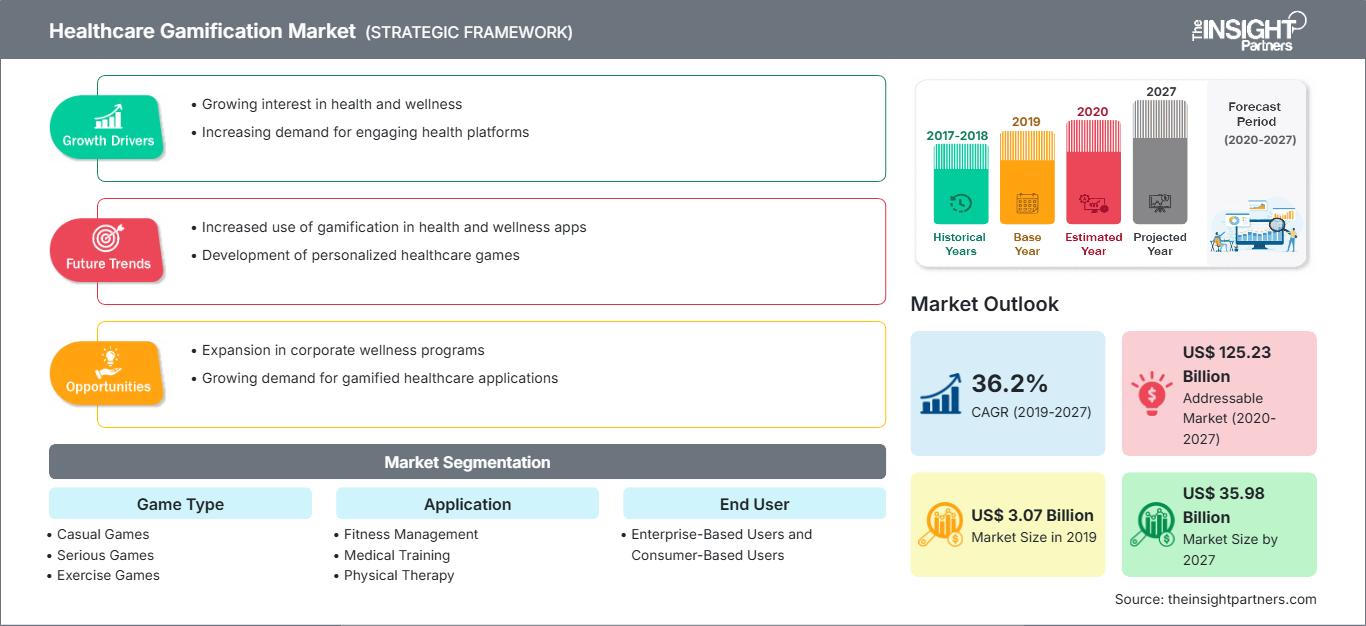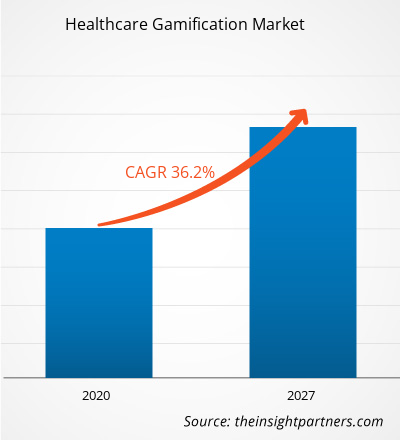[Rapport de recherche] Le marché de la gamification dans le secteur de la santé devrait atteindre 35 982,7 millions de dollars américains en 2027, contre 3 072,5 millions de dollars américains en 2019. Le marché devrait croître à un TCAC de 36,2 % entre 2020 et 2027.
La croissance du marché est attribuée à des facteurs tels que l'adoption croissante de la gamification dans le secteur de la santé et l'augmentation du nombre de lancements de technologies. Cependant, les difficultés d'engagement des utilisateurs à long terme sont susceptibles d'entraver la croissance du marché.
Aperçu du marché : Adoption croissante de la gamification dans le secteur de la santé
L'introduction des jeux dans les soins de santé a débuté début 1975 et a joué un rôle majeur dans la thérapie par le jeu. De plus, les jeux ont récemment attiré l'attention en termes d'aspects thérapeutiques avec l'intégration de l'intelligence artificielle et de la réalité augmentée dans le secteur de la santé. Les jeux offrent aux patients la possibilité de s'exprimer, ce qui est rarement le cas, aidant ainsi les professionnels à concevoir une meilleure thérapie, aboutissant à des résultats thérapeutiques efficaces. Par conséquent, la prévalence croissante de maladies chroniques telles que les maladies mentales et les affections musculosquelettiques et orthopédiques, qui peuvent être traitées dans une certaine mesure par les technologies de jeu, devrait accroître la demande de ludification des soins de santé. La thérapie par le jeu s'avère utile pour traiter les jeunes patients habitués à interagir constamment avec la technologie tout au long de leur vie. De plus, l'introduction de nouvelles technologies telles que la réalité augmentée (RA) et la réalité virtuelle (RV) dans le secteur de la santé aide les professionnels à traiter les troubles mentaux des patients et à faciliter les séances de conseil. Par exemple, en 2016, une équipe de concepteurs de jeux américains a lancé une expérience DEEP-VR qui guide les utilisateurs dans un environnement sous-marin pour apprendre et combattre les symptômes d'anxiété et de stress. De plus, l'intégration d'activités physiques dans les jeux vidéo permet d'intégrer la RV aux thérapies de réadaptation. Par exemple, en octobre 2017, des étudiants de l'Université Rice ont créé un jeu vidéo appelé Equilibrium pour la kinésithérapie pédiatrique. Ce jeu utilise la Wii Balance Board et des barres d'équilibre sur mesure qui encouragent les enfants à améliorer leur capacité à marcher et à acquérir leur équilibre. Ainsi, l'adoption croissante de la ludification à des fins thérapeutiques stimule la croissance du marché de la ludification en santé.
Vous bénéficierez d’une personnalisation sur n’importe quel rapport - gratuitement - y compris des parties de ce rapport, ou une analyse au niveau du pays, un pack de données Excel, ainsi que de profiter d’offres exceptionnelles et de réductions pour les start-ups et les universités
Marché de la gamification des soins de santé: Perspectives stratégiques

-
Obtenez les principales tendances clés du marché de ce rapport.Cet échantillon GRATUIT comprendra une analyse de données, allant des tendances du marché aux estimations et prévisions.
Informations basées sur le type de jeu
Selon le type de jeu, le marché de la gamification des soins de santé est segmenté en jeux occasionnels, jeux sérieux et jeux d'exercice. En 2019, les jeux occasionnels représentaient la plus grande part du marché en raison de leur taux d'adoption croissant chez les enfants et les personnes âgées de plus de 50 ans, grâce à leurs avantages pour l'amélioration des compétences cognitives. La demande croissante incite les entreprises à proposer une large gamme de jeux occasionnels amusants. Cependant, au cours des années prévues, les jeux d'exercice devraient connaître une croissance plus rapide, car ils comprennent des jeux de fitness et des jeux interactifs de mouvement physique. D'autre part, de nombreux prestataires de soins de santé ont collaboré avec des applications d'exercice pour encourager des habitudes saines chez les utilisateurs. Par exemple, le géant de la santé United Healthcare a collaboré sur un programme pilote avec les créateurs de « Dance, Dance Revolution » sur un jeu adapté aux cours de gym pour divertir les enfants et les empêcher de s'asseoir sur le canapé.
Informations basées sur les applications
Le marché de la gamification des soins de santé, par application, est segmenté en gestion de la condition physique, formation médicale, physiothérapie, etc. Le segment de la gestion de la condition physique détenait la plus grande part de marché en 2019. De plus, ce même segment devrait enregistrer le TCAC le plus élevé du marché au cours de la période de prévision.
Informations basées sur l'utilisateur final
En fonction de l'utilisateur final, le marché de la gamification des soins de santé est segmenté en utilisateurs professionnels et utilisateurs grand public. Le segment des utilisateurs professionnels détenait la plus grande part de marché en 2019 et devrait enregistrer le TCAC le plus élevé du marché au cours de la période de prévision.
Les acteurs du marché de la gamification des soins de santé, tels que Cognifit, Mango Health, Bunchball, Ayogo Health Inc., Fitbit, Inc., Akili Interactive Labs, Inc., Nike, Inc., Cohero Health, Inc., Higi Sh Llc et Mysugr, ont adopté plusieurs stratégies, tant organiques qu'externes, pour améliorer leurs revenus et leur positionnement sur le marché. Par exemple, en octobre 2020, TrialCard Incorporated a lancé la version 2.0 de Mango Health. Cette dernière version permet aux prestataires de soins de santé tiers d'accéder à la suite complète de modules d'assistance aux patients de Mango. Cette nouvelle version de la plateforme Mango fera partie d'un programme d'assistance aux patients entièrement intégré pour le lancement prochain d'un nouvel oncolytique oral.
Aperçu régional du marché de la gamification des soins de santé
Les tendances régionales et les facteurs influençant le marché de la gamification des soins de santé tout au long de la période de prévision ont été analysés en détail par les analystes de The Insight Partners. Cette section aborde également les segments et la géographie du marché de la gamification des soins de santé en Amérique du Nord, en Europe, en Asie-Pacifique, au Moyen-Orient et en Afrique, ainsi qu'en Amérique du Sud et en Amérique centrale.
Portée du rapport sur le marché de la gamification des soins de santé
| Attribut de rapport | Détails |
|---|---|
| Taille du marché en 2019 | US$ 3.07 Billion |
| Taille du marché par 2027 | US$ 35.98 Billion |
| TCAC mondial (2019 - 2027) | 36.2% |
| Données historiques | 2017-2018 |
| Période de prévision | 2020-2027 |
| Segments couverts |
By Type de jeu
|
| Régions et pays couverts |
Amérique du Nord
|
| Leaders du marché et profils d'entreprises clés |
|
Densité des acteurs du marché de la gamification des soins de santé : comprendre son impact sur la dynamique des entreprises
Le marché de la gamification des soins de santé connaît une croissance rapide, portée par une demande croissante des utilisateurs finaux, due à des facteurs tels que l'évolution des préférences des consommateurs, les avancées technologiques et une meilleure connaissance des avantages du produit. Face à cette demande croissante, les entreprises élargissent leur offre, innovent pour répondre aux besoins des consommateurs et capitalisent sur les nouvelles tendances, ce qui alimente la croissance du marché.

- Obtenez le Marché de la gamification des soins de santé Aperçu des principaux acteurs clés
- Analyse historique (2 ans), année de base, prévision (7 ans) avec TCAC
- Analyse PEST et SWOT
- Taille du marché Valeur / Volume - Mondial, Régional, Pays
- Industrie et paysage concurrentiel
- Ensemble de données Excel
Rapports récents
Rapports connexes
Témoignages
Raison d'acheter
- Prise de décision éclairée
- Compréhension de la dynamique du marché
- Analyse concurrentielle
- Connaissances clients
- Prévisions de marché
- Atténuation des risques
- Planification stratégique
- Justification des investissements
- Identification des marchés émergents
- Amélioration des stratégies marketing
- Amélioration de l'efficacité opérationnelle
- Alignement sur les tendances réglementaires






















 Obtenez un échantillon gratuit pour - Marché de la gamification des soins de santé
Obtenez un échantillon gratuit pour - Marché de la gamification des soins de santé